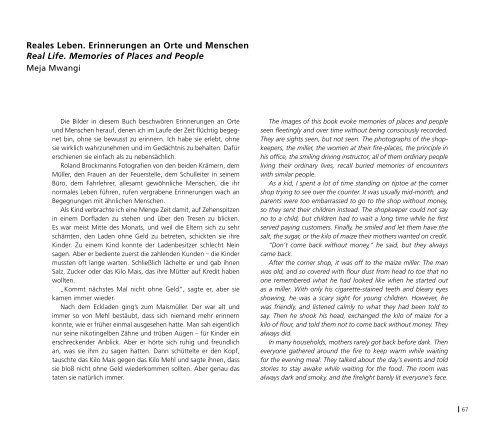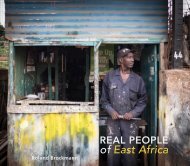Real People of East Africa. Roland Brockmann
From 2016 - 2017 I made four trips through Kenya and Tanzania - travelling over land by minibus, motorbike taxi or on foot. Not to search for something, but to meet the existing, was a great adventure. This photo & text book is about the people I met along my way. They talk about what concerns them: success, failure, love, hope... everyday life. The photos show the people in their living or working environment. And always at eye level. Comming out in december at Photo Edition Berlin. With Essays from Alexis Malefakis and Meja Mwangi. Hardcover. 24 x 21 cm, 112 Pages, 49 images. Language: German/English.
From 2016 - 2017 I made four trips through Kenya and Tanzania - travelling over land by minibus, motorbike taxi or on foot. Not to search for something, but to meet the existing, was a great adventure. This photo & text book is about the people I met along my way. They talk about what concerns them: success, failure, love, hope... everyday life. The photos show the people in their living or working environment. And always at eye level. Comming out in december at Photo Edition Berlin. With Essays from Alexis Malefakis and Meja Mwangi. Hardcover. 24 x 21 cm, 112 Pages, 49 images. Language: German/English.
You also want an ePaper? Increase the reach of your titles
YUMPU automatically turns print PDFs into web optimized ePapers that Google loves.
<strong>Real</strong>es Leben. Erinnerungen an Orte und Menschen<br />
<strong>Real</strong> Life. Memories <strong>of</strong> Places and <strong>People</strong><br />
Meja Mwangi<br />
Die Bilder in diesem Buch beschwören Erinnerungen an Orte<br />
und Menschen herauf, denen ich im Laufe der Zeit flüchtig begegnet<br />
bin, ohne sie bewusst zu erinnern. Ich habe sie erlebt, ohne<br />
sie wirklich wahrzunehmen und im Gedächtnis zu behalten. Dafür<br />
erschienen sie einfach als zu nebensächlich.<br />
<strong>Roland</strong> <strong>Brockmann</strong>s Fotografien von den beiden Krämern, dem<br />
Müller, den Frauen an der Feuerstelle, dem Schulleiter in seinem<br />
Büro, dem Fahrlehrer, allesamt gewöhnliche Menschen, die ihr<br />
normales Leben führen, rufen vergrabene Erinnerungen wach an<br />
Begegnungen mit ähnlichen Menschen.<br />
Als Kind verbrachte ich eine Menge Zeit damit, auf Zehenspitzen<br />
in einem Dorfladen zu stehen und über den Tresen zu blicken.<br />
Es war meist Mitte des Monats, und weil die Eltern sich zu sehr<br />
schämten, den Laden ohne Geld zu betreten, schickten sie ihre<br />
Kinder. Zu einem Kind konnte der Ladenbesitzer schlecht Nein<br />
sagen. Aber er bediente zuerst die zahlenden Kunden – die Kinder<br />
mussten <strong>of</strong>t lange warten. Schließlich lächelte er und gab ihnen<br />
Salz, Zucker oder das Kilo Mais, das ihre Mütter auf Kredit haben<br />
wollten.<br />
„Kommt nächstes Mal nicht ohne Geld“, sagte er, aber sie<br />
kamen immer wieder.<br />
Nach dem Eckladen ging’s zum Maismüller. Der war alt und<br />
immer so von Mehl bestäubt, dass sich niemand mehr erinnern<br />
konnte, wie er früher einmal ausgesehen hatte. Man sah eigentlich<br />
nur seine nikotingelben Zähne und trüben Augen – für Kinder ein<br />
erschreckender Anblick. Aber er hörte sich ruhig und freundlich<br />
an, was sie ihm zu sagen hatten. Dann schüttelte er den Kopf,<br />
tauschte das Kilo Mais gegen das Kilo Mehl und sagte ihnen, dass<br />
sie bloß nicht ohne Geld wiederkommen sollten. Aber genau das<br />
taten sie natürlich immer.<br />
The images <strong>of</strong> this book evoke memories <strong>of</strong> places and people<br />
seen fleetingly and over time without being consciously recorded.<br />
They are sights seen, but not seen. The photographs <strong>of</strong> the shopkeepers,<br />
the miller, the women at their fire-places, the principle in<br />
his <strong>of</strong>fice, the smiling driving instructor; all <strong>of</strong> them ordinary people<br />
living their ordinary lives, recall buried memories <strong>of</strong> encounters<br />
with similar people.<br />
As a kid, I spent a lot <strong>of</strong> time standing on tiptoe at the corner<br />
shop trying to see over the counter. It was usually mid-month, and<br />
parents were too embarrassed to go to the shop without money,<br />
so they sent their children instead. The shopkeeper could not say<br />
no to a child, but children had to wait a long time while he first<br />
served paying customers. Finally, he smiled and let them have the<br />
salt, the sugar, or the kilo <strong>of</strong> maize their mothers wanted on credit.<br />
“Don’t come back without money,” he said, but they always<br />
came back.<br />
After the corner shop, it was <strong>of</strong>f to the maize miller. The man<br />
was old, and so covered with flour dust from head to toe that no<br />
one remembered what he had looked like when he started out<br />
as a miller. With only his cigarette-stained teeth and bleary eyes<br />
showing, he was a scary sight for young children. However, he<br />
was friendly, and listened calmly to what they had been told to<br />
say. Then he shook his head, exchanged the kilo <strong>of</strong> maize for a<br />
kilo <strong>of</strong> flour, and told them not to come back without money. They<br />
always did.<br />
In many households, mothers rarely got back before dark. Then<br />
everyone gathered around the fire to keep warm while waiting<br />
for the evening meal. They talked about the day’s events and told<br />
stories to stay awake while waiting for the food. The room was<br />
always dark and smoky, and the firelight barely lit everyone’s face.<br />
67




